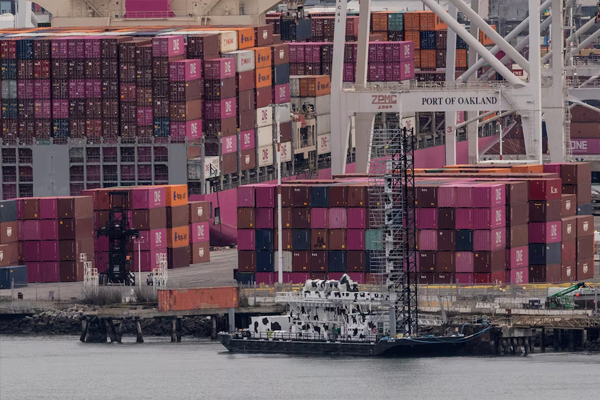
U.S. President Donald Trump’s latest reciprocal tariff plan has unsettled the ocean shipping industry, fueling concerns of a trade war that could weaken transport demand and force companies to navigate its repercussions.
The Trump administration is set to announce “reciprocal tariffs” targeting nations that have duties on U.S. goods. That move would come after it slapped new import levies on products from Mexico, China and Canada – the top U.S. trading partners – as well as on goods including steel and autos.
Major global container shipping firms like MSC, Maersk CMA CGM and Hapag-Lloyd transport towering piles of colourful boxes stuffed with goods for U.S. customers like Walmart Target and Home Depot.
They are giants in the roughly $14 trillion a year ocean shipping industry that handles about 80% of global trade. They are also reliant on companies that are getting whipsawed by Trump’s escalating, on-and-off tariffs.
‘Mounting Confusion’
“The implementation of stacked tariffs has led to mounting confusion,” said Blake Harden, the Retail Industry Leaders Association’s vice president of international trade. “Companies have not had adequate time, certainty, and guidance they need to incorporate these changes and comply.”
Trump has invoked emergency powers to swiftly add, and occasionally retract and reinstate, tariffs during his second term in office.
“Importers don’t know from one week to the next what their duty cost is going to be,” said Kit Johnson, director of import compliance at John S. James Co., a U.S. customs broker and freight forwarder whose customers include automakers and producers of chemicals, machinery, medical devices and textiles.
Johnson has seen an uptick in customers opting for high-cost air shipping for autos and other goods that normally would travel by sea, in a bid to front-run new tariffs.
Imports Surge
U.S. container imports have also surged to record levels in recent months as companies rushed in toys, furniture, bedding, machinery and parts from China, the world’s No. 1 exporter, to avoid Trump’s tariffs.
As that threat expanded, other vessel types and airplanes have been called to help U.S. firms stockpile cars from Europe and the Far East, cheese and wine from Italy, and prescription drugs from Ireland.
The average on-demand spot rate to ship a 40-foot container on the key Far East to U.S. West Coast route was $2,844 on Tuesday, a one-day gain of almost 16%, according to data from freight pricing platform Xeneta. That rate is still lower than a year ago, when the risk of Houthi attacks on Red Sea shipping lanes was a new phenomenon and trading was not distorted by importers seeking to avoid tariffs.
Tariffs Take A Bite
But companies’ knee-jerk, front-loading strategy is just a temporary fix – especially as retaliatory tariffs stoke trade wars that could suffocate demand.
The tariff tiffs come as ocean shipping faces greater potential peril from a separate Trump plan to impose hefty U.S. port call fees on ships with links to China.
Foes of that proposal say it could decimate domestic agriculture and energy exporters that Trump promised to support. They also warn it could reignite pandemic-level chaos at ports by prompting vessel operators to avoid fees by swamping some ports with cargo while starving others.
Layering that on top of tariffs has paralyzed decision-making around how to source, sell and move goods.
“You cannot make important decisions on your supply chain when the rules of the game keep changing,” said Peter Sand, Xeneta’s chief analyst.
One Greek container shipping executive, who requested anonymity due to fear that public comments could negatively affect business, said customers were not loading cargo for fear that a large levy might be imposed at the end of a lengthy ocean voyage.
“We are in a wait-and-see mode.”
Experts have begun counting the harm from Trump’s tariffs.
Anxiety Over Levies
Anxiety over the levies already has helped derail a turnaround in the U.S. manufacturing sector that relies on imports and exports and drives significant demand for transportation, according to responses to the Institute for Supply Management survey.
S&P Global Market Intelligence expects the volume of U.S. ocean container freight imports to drop 0.7% in 2025.
“While there is still strong growth in the first quarter, this is expected to reverse in the second quarter of 2025 as tariffs bite,” S&P said.
Meanwhile, U.S. Customs and Border Protection is scrambling to reprogramme and test systems needed to calculate and collect new tariffs.
The Trump administration in February delayed a plan to begin collecting duties on direct sales of low-value goods from retailers like Temu and Shein after packages piled up at New York’s John F. Kennedy International Airport.
“The more of these tariffs we have, the harder it’s going to be for everyone to keep up,” customs broker Johnson said.
(With inputs from Reuters)




